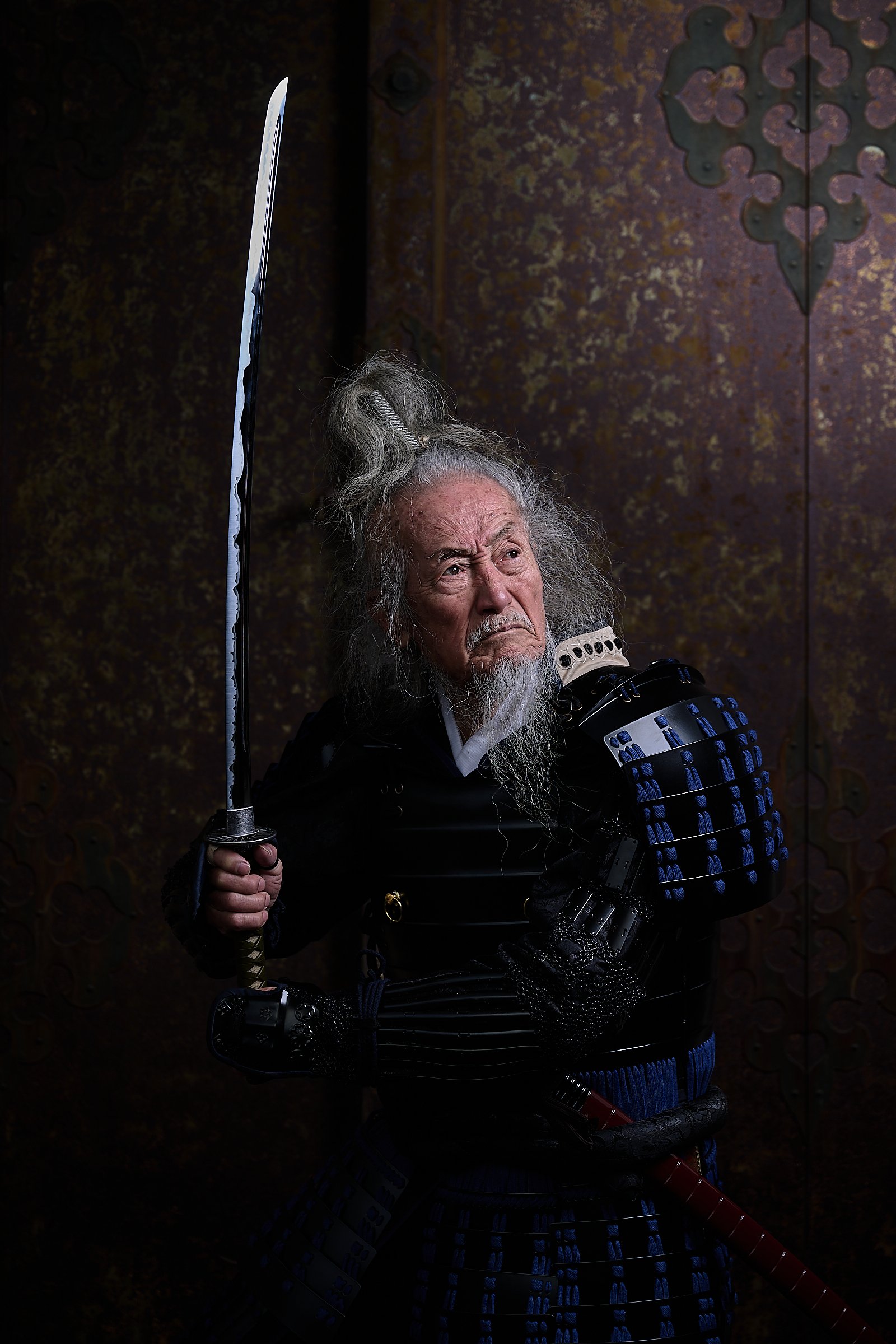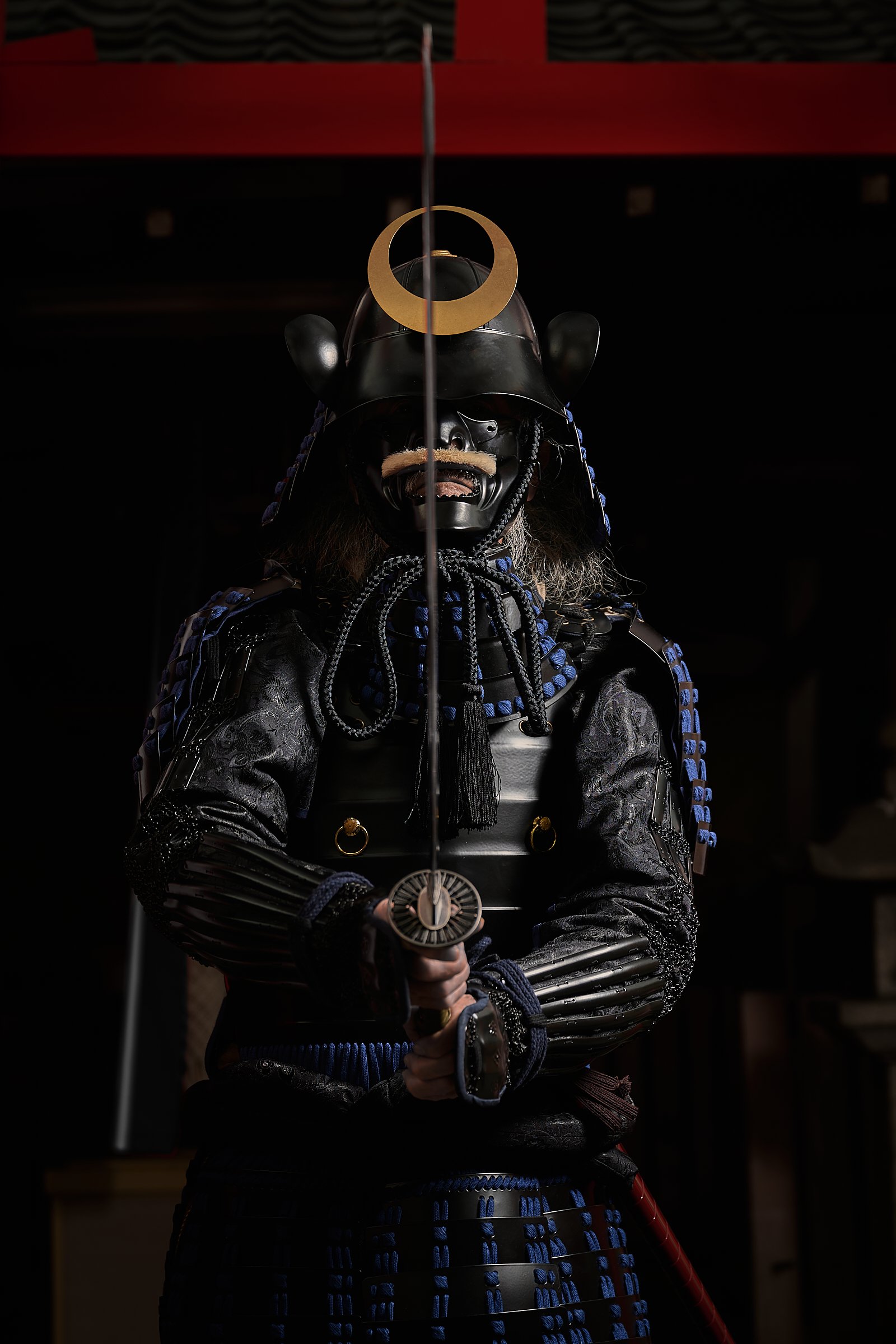About Joe Okada
You have got to admit - Japan and the samurai are, to the imagination, somewhat synonymous. Mysticism, honour, martial arts and, of course, the katana, the focus point of the samurai power and soul. To the photographer, the chance - and challenge - of photographing a real samurai is one of those things. Something we all want to do and yet something which is, well, impossible.
Okada-san resting his katana on the shoulder pads of his armour and standing before a 200yr-old door at his family shrine. The door no longer functions as a door but it did make for an interesting background. Light was a Godox AD1200Pro shot through a 120cm octabox heavily feathered towards the background. Ambient (and there was a lot of light that day) was controlled through a VND.
You see, the samurai are, in that way, extinct. Descendants of the old families still remain, sure, but most of them have left their warrior days behind - some of them have even sold or donated their katanas and armour to museums and private collectors. There are, sure, some still around but they almost seem unwilling to connect to that part of their heritage, let alone done their armour and swords and pose for photos. Of course, this being the 21st century, there are literally hundreds of martial artists who have armour (new ones but really, really good ones) and swords and who can, for a fee, pose for photos and I’m willing to bet, some of those photos would capture how the samurai used to be. But - and I think you know what I’m going to say here - it wont be the real thing. So in the end, it’s about what you as a photographer, are looking for.
Okada-san is such a descendant and one of the very few who chose to go into tourism where he’s been for 67 years. He’s now 97 years old and while this comes clearly across in the photos, he still maintains some of the fierceness one can only imagine the samurai of old would exude. Heck, Okada-san proved this to me beyond any doubt by throwing an apple in the air, drawing his sword and slicing it twice in half before seething the sword back into the scabbard before the slices hit the ground - at 97! Took him a single prep effort to adjust for the weight of the armour, but he nailed it on the second, so, yeah, something to keep in mind.
It was frankly awe-inspiring to not only witness this happening right before my eyes but to also be able to capture it. Thanks to the incredible speed of my strobe the light worked really well - shame about the plastic on the lanterns in the background.
I have to say I don’t think I did Okada-san justice with my photos - I really don’t. In the few short hours we had I focused - partly at his request - on official warrior portraiture and not as much on the man as he’s today, something I truly regret. At the same time, Okada-san is writing a book about his life and these images will feature throughout and those are images he wanted - I was simply the medium through which those images materialised. I hope that in my upcoming return to Japan I will have the opportunity to address this and create more insightful images.
Were I to do this again, how would I approach this? I have been thinking a lot about this - going over my notes, my sketches and inevitably going through old engravings and even the very first photos of the samurai from more than a century ago. Certainly my images were aiming to recreate some of those images (even though, on the day, Okada-san was kind enough to point out that some poses were incompatible with the spirit of the samurai - such as, for example, the shot of a samurai kneeling on one knee or a samurai simply placing his katana on the ground. But were I to revisit this, this is what I would change:
I would shoot Okada-san with his traditional brown-and-cream hakami sitting on the steps of the shrine in a more relaxed, non-warrior-like pose and expression
We would most likely seek another location (which would have posed its own logistical problems of transporting the family sword etc etc, but we would have figured out something) with a bit more mysticism or more varied traditional elements. After all Kyoto is full of those
I would have ensured that Okada-san had tied his hair a little “better”, more like the traditional warrior top-knot and tended his beard a little more. Of course, it’s kind hard to foresee and organise all this with a 97yr-old man, but I should really have anticipated and tried to organise this
I probably would have tried to shoot a lot more photos. Now that would be a bigger challenge than it may sound - honestly. We took it slow as it was because, well, it’s not that easy for Okada-san to walk with the heavy armour and even more with the helmet. Every now and then he needed to rest and refresh himself (and by the end of our 5hrs together he was clearly exhausted) and I would use this time to prep the next location, set up the light, test it etc. I know the temptation might be there to simply spray and pray but that would have resulted in simply more photos, not more varied photos.
I might have tried to incorporate some additional traditional elements in the shots: maybe the flags some samurai would wear in their backs, maybe a fan. The amazing people at Tozando shop would have been more than happy to help me with those aspects
Anyway, could have, should have, would have…right? I usually try not to dwell on my misses (near or wide) or my failures (of which there are way too many), but I have a feeling I might not get a chance to have another go - at least not one that would result in much different shots. For now, please allow me to walk you through the ones we did create.



















